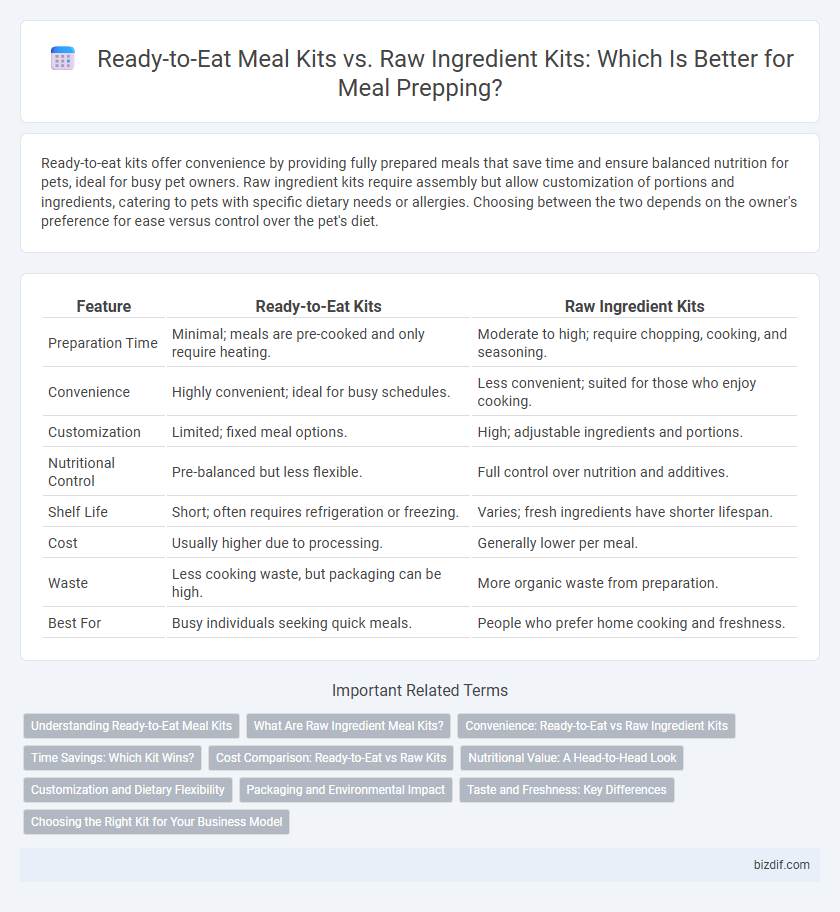Ready-to-eat kits offer convenience by providing fully prepared meals that save time and ensure balanced nutrition for pets, ideal for busy pet owners. Raw ingredient kits require assembly but allow customization of portions and ingredients, catering to pets with specific dietary needs or allergies. Choosing between the two depends on the owner's preference for ease versus control over the pet's diet.
Table of Comparison
| Feature | Ready-to-Eat Kits | Raw Ingredient Kits |
|---|---|---|
| Preparation Time | Minimal; meals are pre-cooked and only require heating. | Moderate to high; require chopping, cooking, and seasoning. |
| Convenience | Highly convenient; ideal for busy schedules. | Less convenient; suited for those who enjoy cooking. |
| Customization | Limited; fixed meal options. | High; adjustable ingredients and portions. |
| Nutritional Control | Pre-balanced but less flexible. | Full control over nutrition and additives. |
| Shelf Life | Short; often requires refrigeration or freezing. | Varies; fresh ingredients have shorter lifespan. |
| Cost | Usually higher due to processing. | Generally lower per meal. |
| Waste | Less cooking waste, but packaging can be high. | More organic waste from preparation. |
| Best For | Busy individuals seeking quick meals. | People who prefer home cooking and freshness. |
Understanding Ready-to-Eat Meal Kits
Ready-to-eat meal kits offer pre-cooked ingredients that save time and require minimal preparation, making them ideal for busy individuals seeking convenience without sacrificing nutrition. These kits typically include fully prepared proteins, vegetables, and sauces that only need assembly or reheating, ensuring consistent flavor and portion control. Choosing ready-to-eat kits can streamline weekly meal planning while reducing cooking stress and food waste.
What Are Raw Ingredient Meal Kits?
Raw ingredient meal kits provide pre-portioned fresh ingredients along with step-by-step recipes, allowing home cooks to prepare meals from scratch. These kits offer flexibility in cooking techniques and flavor adjustments while saving time on grocery shopping and measuring. Ideal for those who enjoy hands-on cooking, raw ingredient kits combine convenience with the experience of creating homemade meals.
Convenience: Ready-to-Eat vs Raw Ingredient Kits
Ready-to-eat meal kits offer unparalleled convenience by eliminating the need for cooking or extensive preparation, making them ideal for busy individuals seeking quick, hassle-free meals. Raw ingredient kits require chopping, cooking, and seasoning, providing flexibility but demanding more time and culinary effort. Choosing between these kits depends on the user's schedule and preference for convenience versus hands-on meal customization.
Time Savings: Which Kit Wins?
Ready-to-eat kits save significant time by eliminating chopping, cooking, and cleanup, offering convenience for busy schedules. Raw ingredient kits require preparation and cooking but provide flexibility for customized meal preferences. Time savings favor ready-to-eat kits for efficiency, while raw ingredient kits appeal to those seeking culinary control.
Cost Comparison: Ready-to-Eat vs Raw Kits
Ready-to-eat meal kits typically cost 30-50% more per serving compared to raw ingredient kits due to pre-cooked convenience and packaging expenses. Raw ingredient kits require additional time for preparation but offer significant savings by allowing bulk ingredient purchases and reducing processing fees. Consumers seeking budget-friendly options often prefer raw ingredient kits to maximize value while maintaining meal variety and nutritional quality.
Nutritional Value: A Head-to-Head Look
Ready-to-eat kits often contain pre-cooked meals with added preservatives and higher sodium levels, potentially compromising nutritional value compared to raw ingredient kits. Raw ingredient kits provide fresher, whole foods that retain more vitamins, minerals, and antioxidants, enhancing overall health benefits. Choosing raw kits allows for better control over portion sizes and ingredient quality, supporting a balanced diet tailored to individual nutritional needs.
Customization and Dietary Flexibility
Ready-to-eat kits offer convenience with pre-portioned, fully prepared meals that require minimal effort but limit customization and dietary flexibility. Raw ingredient kits provide fresh, unprocessed components allowing users to adjust ingredients and portion sizes easily, making them ideal for various dietary needs like keto, vegan, or gluten-free. Customization in raw ingredient kits supports personalized meal planning, accommodating specific nutritional goals and food preferences more effectively than ready-to-eat options.
Packaging and Environmental Impact
Ready-to-eat kits typically use more single-use plastic packaging, increasing environmental waste compared to raw ingredient kits, which often come in minimal, recyclable materials. Raw ingredient kits generate less packaging waste and enable consumers to recycle or compost more efficiently, reducing their carbon footprint. Selecting kits with eco-friendly, biodegradable packaging promotes sustainability in meal prepping and helps decrease landfill contributions.
Taste and Freshness: Key Differences
Ready-to-eat kits offer convenience with fully cooked meals that retain consistent flavor but may sacrifice some freshness due to processing. Raw ingredient kits provide fresher flavors and allow for personalized seasoning and cooking techniques, enhancing overall taste quality. The choice between the two depends on prioritizing immediate consumption versus flavor customization and ingredient freshness.
Choosing the Right Kit for Your Business Model
Ready-to-eat kits offer convenience and speed, ideal for businesses prioritizing quick service and minimal kitchen staff, while raw ingredient kits provide flexibility and customization for chefs aiming to showcase culinary skills. Analyzing customer preferences, kitchen capacity, and operational costs helps determine the optimal choice between ready-to-eat and raw ingredient kits. Incorporating data on preparation time, storage requirements, and menu diversity ensures alignment with the business model and maximizes efficiency.
Ready-to-Eat Kits vs Raw Ingredient Kits Infographic

 bizdif.com
bizdif.com